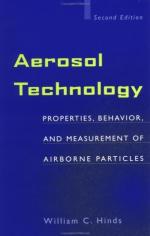|
This section contains 967 words (approx. 4 pages at 300 words per page) |

|
Particulates, or particulate matter (PM), refer to any mixture of solid particles or liquid droplets that remain suspended in the atmosphere for appreciable time periods. Examples of particulates are dust and salt particles, and water and sulphuric acid droplets. The length of time a particle survives in the atmosphere depends on the balance between two processes. Gravity forces the particles to settle to the earth's surface, but atmospheric turbulence can carry the particles in the opposite direction. Under normal conditions, only particles with diameters less than 10 micrometers (μm) remain in the atmosphere long enough to be considered atmospheric particulates. In quantifying particulate matter, it is typical to give the mass of particles less than a particular size per cubic meter of air. For example, 10 μg/m3 PM2.5 means that in 1 cubic meter (m3) of air the mass of all particles with diameters less than 2.5 μm is 10 μg.
 Distribution...
Distribution...|
This section contains 967 words (approx. 4 pages at 300 words per page) |

|


